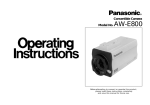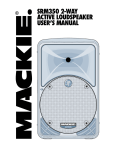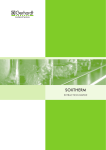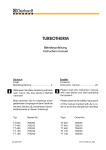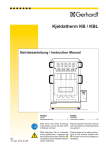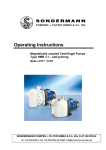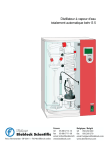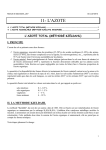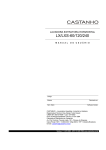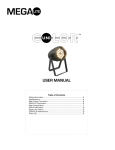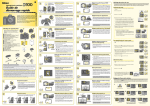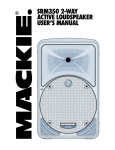Download Service Manual VAP 20/30/40
Transcript
1. General notes for users of the Service Manual VAP 20/30/40 This manual was written exclusive for the service staff of C. Gerhardt GmbH & Co. KG and for the service staffs of our international agencies. This service manual shall help to get a deeper knowledge of how the instruments are constructed and how they work. It is an important tool to service and repair the instruments in a safe, competent and specific way. The transparent structure and the appendix of modification information will enable to order and to store the most useful spare parts. This manual will make servicing easier, in particular for our international agencies. To provide yourself against risks during operation or service, the following safety instructions should be obeyed: Make sure that no liquid gets into contact with cable connections or the interior of the electrical parts of the unit! Danger of electrical shock! Repairs on electrical, electronic or mechanical parts must only be done by authorzied personnel. Always switch off the apparatus at the mains and pull the plug before opening! Danger of electrical shock! The apparatus must be used according to the instruction manual. It is not allowed to make changes to the apparatus in order to modify its application. 2 0 0 2 9 0 3 0 0 2 4 1 2 4 0 2 8 0 3 8 0 2 6 1 2 6 0 5 8 0 1 1 0 0 5 0 3 1 1 1 0 4 4 0 2 5 0 2 5 1 2 1 0 2 7 0 5 1 3 3 0 3 4 0 3 2 0 3 1 0 2 0 1 0 2 2 0 1 1 2 0 2 3 0 2 0 8 0 4 5 0 9 9 5 3 5 0 F r o n t V ie w V A P 2 0 /3 0 /4 0 Date: Key to Front view VAP 20/30/40 Drawing-No. Part-No. 10 20 50 51 80 50014 50015 50018 50020 50003 50012 13308 7472 6470 7673 6474 16604 16607 16602 16606 16601 16609 30698 11810 11811 50021 40234 25102 19015 19016 18250 18251 17542 17940 17945 18404 22705 20903 22704 200 210 220 230 240 241 250 251 260 261 270 280 290 300 310 311 320 330 340 350 380 440 450 580 1100 1120 2010 Description Modif. 1 Case, C.G. yellow Drip tray PP, VAP 20 - 40 Holder VK/DK VAP 20 - 40 Clamp fitting for 50018 Quick clamping device for sample tube, compl. Wedge, PP Switch for clamping device Distribution head, glass Viton cone Distillation condenser Ventilation valve, PP, for distillation condenser Screw cap GL 32, open Silicone seal GL 32 Screw cap GL 18 Silicone seal GL 18 Screw cap GL 14 Silicone seal GL 14, with tubing connection PTFE - sieve for steam inlet tube PTFE - inlet tubing, steam PTFE - inlet tubing, NaOH Distance piece for distribution head Tubing holder for H3BO3 Dummy plug for 8mm hole Plexiglass protection door, bottom Plexiglass protection door, top Door hinges Door handle PP-tube joint Rubber foot, 5mm Rubber foot GF 21, self-adhesive Cable binder Silicone tubing 8/16 Silicone tubing 6/10 Silicone tubing 8/12 02.05.96 02.05.96 02.05.96 16.03.95 Page 1 Modif. 2 Modif. 3 Modif. 4 1 1 6 0 4 0 0 3 9 0 3 6 0 4 1 0 1 1 1 0 1 6 3 1 6 21 1 7 01 6 0 1 6 2 4 9 0 1 0 3 7 0 S 3 3 8 5 7 3 4 5 6 4 5 5 1 1 1 0 9 0 S 2 S 3 1 1 7 0 S 2 4 3 0 7 0 1 1 5 0 5 2 4 S 1 8 6 8 S 1 to c o n d e n s e r 3 0 9 9 0 4 8 0 8 1 8 0 2 9 0 9 9 0 4 0 9 9 8 5 2 0 R e a r V ie w 4 8 6 6 0 V A P 2 0 /3 0 /4 0 Date: Key to Rear View VAP 20/30/40 Drawing-No. Part-No. 10 30 40 60 70 80 81 90 50014 50016 50017 50019 40850 50003 13308 40890 40891 40892 10385 10389 11003 40269 11811 50024 40249 40239 10318 10317 50023 27309 27310 18411 25121 17914 17920 23230 23002 20914 20920 20921 20919 160 161 162 163 290 360 370 385 400 410 430 455 456 480 486 490 520 600 610 1110 1150 1160 1170 Description Case, C.G. yellow Pump-holding module VAP 20 - 40 (see 4.1) Tubing-connection module VAP 20 - 40 (see 4.2) Rear cover VAP 20 - 40, C.G. yellow Steam Generator DE 94 (see 4.5) Quick clamping device for sample tube, compl. Switch (Tube present) PCB-module 230 V, VAP 20, compl. (see 4.3) PCB-module 230 V, VAP 30, compl. (see 4.3) PCB-module 230 V, VAP 40, compl. (see 4.4) Pinch-solenoid valve S 307 Tube holding device for valve 10385 Plug with bridge rectifier for valve 10385 Ventilation vessel, glass PTFE inlet tube, NaOH PP - connector Screw connection, (part 3) for 50024 PP - dummy plug for 50024 PP - connection, bent, DN 08 R 1/8" PP - connection, bent, DN R 1/8" Tubing connection, PP, 51x10x5 Silicone - red 15x80x5 (base for Steam Generator) Silicone - red 15x15x3 (base for Steam Generator) Guiding spout Cap Heyco, d = 22,5mm Band clamp fitting OBO - Quick PG 21 Clamp 12H8074 Set screw VA M4x30 DIN 551 Label for ground connection, M4, 9x18, Al Silicone-tubing 4x7, from pump H2O to 50024 Verprene-tubing 4x8 Verprene-tubing 8x12 Neoprene-tubing 4,8x1,6 approx. 170mm and 520mm Modif. 1 Modif. 2 11.08.95 27.09.95 20.06.95 20.06.95 30.03.95 Modif. 3 Modif. 4 9 8 0 8 0 0 to s te a m g e n e ra to r (re a r) to 5 0 0 2 4 5 E 1 2 4 to to g r o u n d c o n n e c t io n 1 0 0 6 9 0 R e c e iv e r 5 6 6 0 1 0 0 2 1 0 0 E 1 E 2 to to 5 0 0 2 4 D is t r ib u tio n H e a d 8 0 0 9 8 1 4 6 2 9 0 t o c o n n e c t io n p ie c e 5 1 x 1 0 x 5 E 2 to S a m p le T u b e C la m p in g D e v ic e 5 7 0 9 9 2 6 6 8 0 1 1 0 9 9 2 3 0 9 9 0 4 8 0 1 0 0 4 1 0 7 0 0 4 0 0 P u m p H o ld in g M o d u le V A P 2 0 /3 0 /4 0 Date: Key to pump-holding module VAP 20/30/40 Drawing-No. Part-No. 30 100 110 290 400 410 480 570 660 680 690 700 800 980 981 50016 10310 10360 11811 10318 10317 18411 22701 18421 18423 17424 18425 11140 20050 20072 Description Pump-holding module VAP 20 - 40 Diaphragm-pump PML 1140-ND100 Peristaltic-pump SR25 230 V PTFE - inlet tubing NaOH PP - connection, bent, DN 08 R 1/8" PP - connection, bent, DN 06 R 1/8" Guiding spout Clamp VZ N10 SES Markers S-9-J/2 SES Markers S-9-J/4 SES Markers S-9-J/5 SES Markers S-9-J/6 Multiple contact strip Insulation tube sw 6x0,5 Insulation tube sw 5x0,5 (see 6.0) Modif. 1 Modif. 2 30.03.95 15.12.95 Modif. 3 Modif. 4 8 0 0 8 to s a m p le tu b e c la m p . d e v ic e to P o w e r P C B 1 5 0 8 to c o n d e n s e r 4 2 0 to p e r is ta lt ic p u m p (p re s s u re ) 4 8 5 4 3 0 to c o n d e n s e r 1 1 0 0 9 9 0 4 0 5 1 0 5 0 0 1 1 5 0 T u b in g C o n n e c tio n M o d u le V A P 2 0 /3 0 /4 0 Date: Key to tubing connection module VAP 20/30/40 Drawing-No. Part-No. 40 150 420 430 485 500 510 800 990 1100 1150 50017 17109 50022 50023 25120 17908 17907 11140 17960 22705 20920 Description Remark Tubing-connection module VAP 20 - 40 Magnetic valve with pressure control 0,5 bar, 5 l Connection piece, PP, 51x10x10 Connection piece, PP, 51x10x5 (only VAP 30/40) Cap, Heyco, d = 15,1mm (only VAP 20) Band clamp fitting Band clamp fitting (only VAP 30/40) Multiple contact strip VA - screw 1411 KA 50x25 Silicone tubing 8x16 Verprene tubing 4x8 (only VAP 30/40) Modif. 1 Modif. 2 Modif. 3 1 1 a 1 0 2 0 to p re s s u re s e n s o r ( c o o lin g w a te r ) 4 0 1 2 3 to m ic r o ( tu b . c la to S g e n 4 5 6 7 8 f1 g 1 s w itc m p . d te a m e ra to h e v ic e ) r (fro n t) f2 rd t rh a G e g 2 5 1 b 1 d b 2 d c 1 3 0 s t d e p o V a e 1 e 2 b 3 2 f2 a 4 1 3 5 0 b 3 b 4 h 1 f1 h 1 h 2 b 4 c 2 8 0 to re a r c o v e r to g r o u n d c o n n e c tio n c 1 c 2 h 2 7 0 , 7 1 b 1 e 1 e 2 b 2 g 2 6 0 7 2 g 1 9 0 P C B - m o d u le V A P 2 0 /3 0 Date: Key to PCB-module VAP 20/30/40 Drawing-No. Part-No. 10 11222 11225 11223 11227 11213 11214 11215 11750 15350 15351 14401 21417 21420 12703 18690 17916 11 12 20 40 50 51 60 70 71 72 80 new Description Control - PCB VAP 20/30 Control - PCB VAP 40 Power - PCB 230 V, VAP 20/30/40 Display VAP 40 Keyboard VAP 20 Keyboard VAP 30 Keyboard VAP 40 Switch, green illuminated Semiconductor relay WG-A5-6D25 Cap for 15350 Plug connection 161.5, for mains cable Fuse holder, 16 A Bayonet type cap for fuse 5x20 (for 21417) Socket with byonet catch, 3 pin Plug housing 021 032 660 Clamp fitting (for tube at pressure sensor) Modif. 1 Modif. 2 Modif. 3 Modif. 4 2 0 4 0 1 0 1 1 a 1 2 rd t rh a G e to p re s s u re s e n s o r ( c o o lin g w a t e r ) 1 2 3 to m ic r o s w itc h ( t u b e c la m p . d e v ic e ) 4 5 6 b 1 7 8 d to S te a m g e n e ra to r (fro n t) f1 g 1 b 2 b 3 b 4 h 1 f2 g 2 4 0 s t d e p o V a a 5 1 d c 1 e 1 e 2 b 3 2 f2 4 1 3 5 0 f1 h 1 h 2 b 4 c 2 8 0 to re a r c o v e r to g r o u n d c o n n e c t io n c 1 c 2 h 2 7 0 , 7 1 b 1 P C B - m o d u le e 1 e 2 b 2 g 2 6 0 7 2 g 1 9 0 V A P 4 0 3 2 0 2 1 0 2 0 0 3 3 0 1 4 0 3 1 0 5 0 2 5 3 5 5 1 5 3 0 0 5 0 0 E 2 5 0 5 3 5 0 E 1 5 0 0 5 3 0 8 9 0 E 2 3 4 0 4 0 0 E 1 S te a m G e n e ra to r V A P 2 0 /3 0 /3 0 3 2 0 n e w s e n s o r , P a r t- N o . 4 0 8 5 7 s in c e ( 1 2 /9 5 ) 3 3 0 5 1 5 3 0 0 5 0 0 E 2 5 0 5 3 5 0 E 1 5 0 0 5 3 0 8 9 0 E 2 M o d ific a tio n 1 1 .0 8 .1 9 9 5 , P a g e 2 3 4 0 4 0 0 E 1 T o g e th e r w ith th e c h a n g e m e n t o f th e le v e l s e n s o r , a ls o th e s te a m g e n e r a to r h a s b e e n c h a n g e d . U n d e r th e s a m e P a r t- N o . 4 0 8 5 0 n o w o n ly th e n e w s te a m g e n e r a to r w ill b e d e lie v e r e d . Date: Key to steam generator VAP 20/30/40 Drawing-No. Part-No. 140 300 320 330 340 350 400 890 40863 21115 20604 20620 12354 12307 18787 18691 Description Level sensor Multitherm 550 HD, 400x500x3mm Excess-pressure valve, 604T SKT - Ventilation valve Tubular heating element, 230 V Excess-temperature device Plug-in connection piece + label for ground connection Plug 020 030 660 Modif. 1 11.08.95 Modif. 2 Modif. 3 Modif. 4 F A rt.-N r. 1 0 3 2 9 Y D L /N M 2 E M 1 B Z C K D ia p h r a g m 1 0 3 1 0 P u m p Spare parts for diaphragm pump 10310 1) Pump-head comprising of the following parts: Part-No. 10330 10325 10322 10323 10326 10320 10327 10328 10324 17911 17910 10321 Drawing-No. F D B C,E K Y M1 M2 L,N Z Description Cover of pump head Connection-piece for square connections Distance piece O-Ring O-Ring Diaphragm Valve plate (PTFE) Valve plate (stainless steel) Clamp for valve tiles Angle-connection (inlet ) Angle-connection (outlet ) Diaphragm with lip and screw Quantity 1 1 1 2 1 1 2 2 2 1 1 1 Attention ! In instruments Vap 20/30/40 there are different angle-connections for the pump NaOH. Angle-connections Part-No. 17911 and 17910 are replaced against the following connections. 10317 10318 20918 - PP - angle-connection ( NaOH - outlet ) PP - angle-connection ( NaOH - inlet ) Isoversinic-tubing see modification 2 from 30.03.1995 For pumps H2O Part-No. 17911 and 17910 are valid. 2) Other spare parts are not available. In case of damage customers only can order the complete pump 10310 . 1 1 1 Date: Spare parts and accessories VAP 20/30/40 Part-No. 18560 18561 18562 18564 18565 18566 18567 18568 18569 26926 26925 22802 25450 25451 20921 22601 22604 1311 7629 7639 7649 6471 4260 4261 4262 4264 4265 Description PC - Label 67x72: Caution ! Before opening rear wall... PC - Label 32x50: Pump Suction (VAP 30/40) PC - Label 32x50: Pump H2O-sample (VAP 30/40) PC - Label 18x36: Cooling water outlet PC - Label 22x41: Pump NaOH PC - Label 18x79: Excess-temperature device PC - Label 18x78: Excess-pressure outlet PC - Label 32x50: Cooling water inlet with sieve PC - Label 32x50: Pump H2O-steam generator PC - Label 95x59: inside the instrument PC - Label 130x98: rear of PCB module Water inlet tubing 10/17, 2m PVC - pipe 6x1 PVC - pipe 10x1 Verprene-tubing 8/12 (for sample waste VAP 30/40) PVC - tubing 4/7, 2m (for pumps H2O dist.) PVC - tubing 8/12, 2m (for tank NaOH and cooling water outlet) Mains cable, 2m Set of tanks KAN20, with level switch Set of tanks KAN30, with level switch Set of tanks KAN40, with level switch Viton cone VK micro, for 100ml tubes KMT RS 232/485 ARS Data cable DK 42 for RS 485, 2m Data cable DK 45 for RS 485, 5m Data cable DK 22 for RS 232, 2m Terminator AST Modif. 1 Modif. 2 Modif. 3 Date: Modification kit Devarda for VAP 20/30/40 Part-No. 7474 7475 30244 7676 40213 50025 16604 16607 Description PP - distribution head Devarda, VPD 7, bottom Distribution head Devarda, glass, VGD 7, top Ventilation valve for condenser, glass Condenser, shortened PP - adaptor PP - distance piece for distribution head Screw cap GL 32, open Silicone - seal GL 32 Modif. 1 (instead of 7472) (instead of 7472) (instead of 7673) (instead of 50021) Modif. 2 Modif. 3 Date: Modification kit Bi-dist for VAP 20/30/40 Part-No. 50027 50026 17103 17110 40231 17908 17907 25121 25122 11140 18424 18560 18564 18565 18566 18567 18568 18569 18561 18562 Description Holder for customer´s Bi-Dist installation Rear cover C.G. (instead of 50019) Magnetic valve without pressure control Flow control for cooling water, MR 05 Sample outlet, PP transparent Clamp VZ 12-22/9 Clamp VZ 8/7 (VAP 30/40) Cap Heyco, d = 22,5mm Cap, Heyco, d = 34,8mm (VAP 20) Multiple contact strip SES - Markers S-9-J/5 PC - Label 67x72: Caution! Before opening rear cover... PC - Label 18x36: Water outlet PC - Label 22x41: Pump NaOH PC - Label 18x79: Excess-temperature device PC - Label 18x78: Excess-pressure outlet PC - Label 32x50: Cooling water inlet with sieve PC - Label 32x50: Pump H2O-steam generator PC - Label 32x50: Pump suction (VAP 30/40) PC - Label 32x50: Pump H2O-sample (VAP 30/40) Modif. 1 Modif. 2 Modif. 3 Date: Other parts and accessories for VAP 20/30/40 Modification to PP- distribution head Part-No. 7482 7676 Description PP - distribution head VAP 20 Distillation condenser VAP 20 Quantity (instead of 7472) (instead of 7673) Modif. 1 Modif. 2 Modif. 3 Modif. 1 Modif. 2 Modif. 3 Modif. 1 Modif. 2 Modif. 3 Modif. 1 Modif. 2 Modif. 3 1 1 Modification to Büchi Part-No. 7483 Description Distribution head, glass Quantity (instead of 7472) 1 Modification to micro Part-No. 6471 Description Viton cone micro Quantity 1 Modification to acid-restistant Part-No. 30244 20918 27101 10327 Description Ventilation valve, glass (instead of non-return valve 10329) Isoversinic-tubing 6x12 (instead of PVC-tubing at pump NaOH) Clamp VA 6-16 (to fasten 20918) Valve plate PTFE for pump NaOH Quantity 1 45mm 2 30.03.95 30.03.95 15.12.95 8.0 Steam Generator 8.1 General description of steam generation After switching-on the Vapodest the electronics measures the level of water inside the steam generator via the level sensor. In case of a level below minimum, the pump for H2O steam generator is switched on until the level sensor detects sufficient water inside the steam generator. This will take some seconds. Then the semiconductor relay switches on the tubular heating element with maximum power to reach the necessary steam pressure for the distillation. When this pressure is reached, the maximum heating power is switched off and the instrument reverts to stand-by with a regulated and controlled heating. The instrument now is ready for distillation. When starting a distillation the instrument will heat with a selected power from 30% - 100% (VAP 20/30) or 40% - 100% (VAP 40). The steam will reach the sample tube via pinchsolenoid valve(s), ventilation glass, PP-distributor and steam inlet tube. During this procedure the level inside the steam generator will decrease. This is recognized by the level sensor and the pump H2O for the filling of the steam generator will be switched on. If there is no sample tube present or if the tap for cooling water is not open, a distillation is not possible. Remark: Especially if the water for the steam generator is not very clean or if there any kind of dirt within the reservoir, the following problem may occur: - After some distillations the instrument shows the error message „E3“, no water for steam generator and the program stops. - After pressing „RUN“ the display shows „H“, wait for steam. Explanation: If the steam generator is contaminated with dirt, the boiling and bubbling water will build up foam above the water level. The level sensor detects the foam as water and prevents the pump from running even though the water level in the steam generator is not sufficient. After some time the liquid level or the foam will have diminished to such an extent that no more liquid is detected, and the system switches on the pump. Within 15 s a sufficient water level should now be detected. As this is not possible in such a short time the error „E3“ will appear on the display. If the „RUN“ key is now pressed, the system will get into the filling mode and the steam generator will be filled to the height stipulated. However, at the same time, due to the cold water, the steam pressure collapses, and the unit heats up again until stand-by is reached. Only now further distillations can be run. So please note that a reaction as described is not a malfunction, but a sign of unwanted foam in the steam generator. If this happens, clean the steam generator and the reservoir. 8.2 Safety devices for steam generation 8.2.1 8.2.2 8.2.3 8.2.4 8.2.5 8.2.1 Level sensor Excess-temperature device Pressure sensor Excess-pressure valve Micro switch for sample tube Level sensor The level sensor constantly controlls and regulates the level of water inside the steam generator.The sensor itself is constantly checked by the electronics; in case of a malfunction, the instrument will give an error message. If the level detection system fails totally, the tubular heating element will be switched off in case of a level decreasing under the allowed minimum range. The level sensor can only compare between insufficient or sufficient water inside the steam generator. This is done by changing the frequency it sends to the Control-PCB. 8.2.2 Excess-temperature device In case that due to a total failure of the level sensor and the control electronics lack of water in the steam generator cannot be detected, the tubular heating element must be protected against overheating. In such a case the excess-temperature device will switch off the heating circuit at about 150°C. After trouble shooting and cooling off of the steam generator the pin of the excess-temperature device has to be pressed back into position. Now the next distillation can be started. 8.2.3 Pressure sensor The pressure sensor is placed directly on the Control PCB and continuously checks the pressure inside the steam generator. If this sensor detects a higher pressure than 0,45 bar, the tubular heating element is switched off, and the instrument gives an error message. 8.2.4 Excess-pressure valve In case of a total failure of pressure sensor and control electronics, the instrument must be protected against an increasing pressure. At about 0,5 bar the excess-pressure valve will open mechanically so that any damage of the instrument can definitely be avoided . If this happens, the instrument has to be switched off immediately. 8.2.5 Micro switch for sample tube This switch ensures that a distillation is not run without a sample tube. In case you try to start the system without a sample tube, the start is prevented by the switch. Thus there is no danger of scalding. 8.3 Testing the safety devices for steam generation 8.3.1 Level sensor 8.3.2 Excess-temperature device 8.3.3 Pressure sensor 8.2.4 Excess-pressure valve 8.2.5 Micro switch for sample tube 8.3.1 Level sensor With a filled steam generator a frequency < 20 KHz should be measured. With an empty steam generator a frequency >130 KHz should be measured. Measurement of the frequencies VAP 20/30: To measure the frequency the gauge has to be connected to collection plug P4 at pins 2 + 3. P4 is to be found on the Power PCB, above those orange coloured plugs.The occupation of P4 is to be found in the circuit diagram (see 4.2). P4 KHz 8 7 Measurement of frequency VAP 40: At instruments of the type Vapodest 40 the frequency can be checked with the inbuilt test. program without opening the rear wall. To enter the test-program the keys „ “ and „ 9 “ have to be pressed at the same time. The instrument shows the menu display for the I/O Test and the frequency can be read: filled steam generator empty steam generator . H(igh) about 5 KHz L(ow) about 90 KHz To quit the test-program the keys „ “ and „ Reset “ have to be pressed at the same time. It is also possible to measure the frequency as in the description for VAP 20/30. The same values are valid. 8.3.2 Excess-temperature device The adjustment of the excess-temperature device should not be changed. It has been adjusted here at C. Gerhardt so that an excess-temperature of about 150° C will open the heating circuit. This device is directly switched into the the 230 V circuit. A damaged excesstemperature device should not be bridged but replaced immediately. 8.3.3 Pressure sensor The pressure sensor is maintenance-free. In case of problems with pressure measuring or in case of a broken pressure sensor, the complete Control - PCB has to be changed (see 10.). The way to measure the pressure inside the steam generator is as follows: VAP 20/30 When the Vapodest is still cold, a gauge for pressure measurement 0 - 1 bar has to be connected into the line from steam generator to pressure sensor as the schematics shows. If available, connect an instrument to measure the current the instrument draws into the mains circuit. Switch on the Vapodest. The electronics will measure the level of water inside the steam generator and, if necessary, the pump for H2O will run. Then the heating element is switched on. When the pressure inside the steam generator begins to increase, the ventilation valve will close, and the pressure of about 0.2 bar will build up. The instruments switches into stand-by and indicates that it is ready for distillation. If the instrument goes into stand-by well below or well above than 0.2 bar, the Control-PCB has to be replaced (see 10.). When measuring the pressure it is important to make sure that all tubing connections are fixed properly. The connections should only be loosened when the instrument has cooled down: Risk of scalding because of hot steam of more than 100°C! to steam valve bar to pressure sensor steam generator H2O steam generator VAP 40 At instruments of the type Vapodest 40 the pressure can be checked with the inbuilt test. program without opening the rear wall. To enter the test-program the keys „ “ and „ 9 “ have to be pressed at the same time. The instrument shows the menu display for the I/O test. The pressure as measured by the pressure sensor can now be read. . To quit the test-program the keys „ “ and „ Reset “ have to be pressed at the same time. 8.3.4 Excess-pressure valve The adjustment of the excess pressure valve should not be changed. It has been adjusted here at C. Gerhardt so that an excess-pressure of about 0.5 bar will activate the valve. The following instructions will help to adjust the excess-pressure valve if it becomes necessary nevertheless. When the Vapodest is still cold, a gauge for pressure measurement 0 - 1 bar has to be connected to the steam generator as the schematics show. The tubing to the pressure sensor is left without any connection to prevent the switching off of the heating when reaching a pressure of 0.2 bar. If available connect an instrument to measure the current the instrument draws into the mains circuit. to steam valve bar to pressure sensor X steam generator H2O steam generator Switch on the Vapodest. The electronics measures the level of water inside the steam generator and, if necessary, the pump for H2O will run. When a sufficient water level is reached the heating element is switched on. When the pressure inside the steam generator begins to increase the ventilation valve will close, and the pressure is able to increase more and more because of the disconnected pressure sensor. Observe carefully the increasing pressure, and make a note at which pressure the excess-pressure valve opens. In case that the valve does not open at a pressure of about 0.5 bar, immediately switch off the instrument! Excess-pressure valve has to open earlier (lower pressure): Remove the brass cap and slightly loosen the big nut. Turn the adjusting screw slightly anticlockwise, and tighten the nut very well. Take care that the adjusting screw stays in the adjusted position. When the adjustment is done, repeat the above described procedure to test the excess-pressure valve. Excess-pressure valve has to open later (higher pressure): Remove the brass cap and slightly loosen the big nut. Turn the adjusting screw slightly clockwise, and lock the nut very well. Take care that the adjusting screw stays in the adjusted position. When the adjustment is done, repeat the above described procedure to test the excess-pressure valve. When measuring the pressure it is important to make sure that all tubing connections are fixed properly. Carefully observe the increasing pressure and make sure you do not touch the hot excess-pressure valve. The connections should only be opened when the instrument has cooled down: Risk of scalding because of hot steam of more than 100°C! 8.3.5 Micro switch for sample tube This switch prevents the start of a distillation without any sample tube. Without a tube the switch is activated, which means that the circuit is open. With a sample tube the switch is not activated, and the circuit is closed.The switch is located inside the instrument directly fixed on the clamping device for the sample tube. 8.4 General description of steam inlet / sample suction Steam inlet: During stand-by steam of about 0.2 bar only reach the steam valve. During stand-by both valves, steam valve and shut-off valve are dead. After starting a distillation, the steam valve gets alive which means it will open. The ventilation valve however, still stays dead, so that it is open for steam. The steam now can pass through the steam valve, ventilation glass, shutoff valve, PP-distributor and steam inlet tubing into the sample tube. From there the distillate will pass through the distribution head and the condenser into the receiver. The ventilation valve of the condenser must be closed. The steam can also pass through the PP-distributor until it reaches the pump for sample suction. Steam will also pass through the tubing for the dilution of the sample until it reaches the non-return valve of the pump for H2O sample. a) Way of steam during stand - by 3 2 1 4 5 Steam Generator 6 7 b) Way of steam during distillation 2 3 1 4 5 Steam Generator 6 7 1 = Shut-off valve 2 = Ventilation glass 3 = Steam valve 4 = PP - connector 5 = Inlet tube steam 6 = Tubing H2O sample 7 = Tubing suctioning Sample suction: After the distillation the steam valve will not draw current any longer, and it closes the path to the ventilation glass. For suctioning now the shut-off valve will get alive and it closes the tubing. too. Consequently the pump for sample suctioning is able to empty the sample tube. In this case the ventilation valve of the condenser must open. If not, the pump will also empty the receiver. The pump for sample suction also draws against the pump for sample dilution. 3 2 1 4 5 Steam Generator 6 7 8 9 sample tube 8 = Pump suctioning 9 = Pump H2O sample 9.1 Diaphragm pump The diaphragm pumps used in VAPODEST instruments are almost maintenance-free. Depending on the kind of liquid the volume the pumps deliver is about 100ml / 10 s. Make sure that the tanks are not placed in a higher position than the instrument itself. It may occur that the volume becomes less than the normal range because of dirt deposit inside the pump housing. In this case the pump and the valves inside the pump housing should be cleaned. Cleaning the valves: To clean the pump it is necessary to disconnect all the tubes and to remove the rear wall. Loosen the 4 screws from the badly working pump, and take away the cover of the pump head. Also take away the connection-piece for angle connections and the diaphragm. Carefully loosen the clamp for the valve plates and the valve plates themselves. Clean all the parts and re-assemble the pump ensuring that all parts are put back into the right position. Close the rear wall, and do not forget the ground connection! Install again all the tubings and let the instrument run to see if everthing works well. L D M1 / M2 ( see 6. ) L D M1 / M2 = Clamp for valve tiles = Connection piece for square connections = valve plates 9.2 Peristaltic pump Also the peristaltic pumps are maintenance-free. At least once a year the neoprene tubing should be replaced: - Remove inlet and outlet tube - Twist s-shaped bar on the left hand side of the pump - Take out the plastic housing containing the tubing - When fitting the new tubing ensure that the u-shaped lugs locate in their recesses to fix the tube into the plastic housing - The complete plastic housing is now inserted into the guides of the pump body before locking in position with the S-bar S-shaped bar Description Plastic housing for tubing Spare tubing Neoprene Guides for the pump body. S-shaped locking bar plastic housing Part-No. 10327 10370 10371 10373 Replacement of the Control PCB With the new Vapodest 20/30 it is possible to exchange the Control PCB from a Vap 20 to a VAP 30. In case of a service it will now be easier to have the right PCB on stock because now it does not matter any longer if the PCB is for a VAP 20 or for a VAP 30. The software will check which keyboard is present, and then the processor will adapt the PCB. In order to ensure that the software will work after the replacement of the Control PCB it is necessary to press „PROG“ and „RESET“ at the same time and to switch on the instrument while still pressing the keys. Modification 16.03.1995 Draw.-No. 1120 Part.-No. 20903 The tubing with part-no.: 20903 is shortened to a length of 150 mm. When installing the shortened tubing the angle has to be adjusted to the angle of the condenser outlet. adjust angle of tubing Modification beginning with series numbers: VAP 20 from VAP 000233 VAP 30 from VAP 000182 Modification 1 from 30.03.1995 Draw.-No.: Part-No.: 1150 20920 only VAP 30/40 The silicone-tubing part-no. 20914 from pump H2O to PP-distributor is replaced against Verprene-tubing Part-No. 20920. Additionally there is clamp Part-No. 17907 used. It fixes the new tubing to the PP-distributor. Modification beginning with series numbers: VAP 20 from VAP 000242 VAP 30 from VAP 000183 Modification 2 from 30.03.1995 Only diaphragm pump NaOH, Part-No. 10310! The PVC-tubing between PP-angle connection (10317) and the PVC non-return valve (10329) is replaced against Isoversinic-tubing part-no. 20918. The other diaphragm pumps are not modified. Additionally there are 2 clamps Part-No. 27101 used to fix the new tubing on both ends. Modification beginning with series numbers: VAP 20 from VAP 000242 VAP 30 from VAP 000183 Modification 20.06.1995 Draw.-No.: Part-No.: 160, 163 10385, 40269 Due to modifications of the solenoid pinch valves the following kit is to be used for replacement: Modification-kit part.-no.: 2/760050 2. After modification ventilation glass part-no. 40269 is replaced by ventilation glass part-no 40272.(Part of modification kit) Modification beginning with series numbers: VAP 20 230 V 240 V VAP 000294 VAP 000180 VAP 30 230 V 240 V VAP 000379 VAP 000173 VAP 40 230 V VAP 000349 Modification 11.08.1995 As the technology of the new level-sensors has changed, they now have 4 contacts instead of 3. If you have to install one of the new sensors/boilers into older instruments, you will have problems with the connections at VAP 20/30. In order to do so you have to modify the cabling between the power PCB and sensor plug. Depending on the cabling of the sensor there are two possible ways of modification: Older version: cabling white, brown, green 1 green brown white 1 P1, sensor PCB P4, VAP 20-40 power PCB ground, boiler Newer version: cabling blue, brown, black 1 1 black brown blue P1, sensor PCB P4, VAP 20-40 power PCB ground, boiler Modification beginning with series numbers: VAP 20 VAP 30 VAP 40 230 V 240 V 230 V 240 V 230 V VAP 000279 VAP 000180 VAP 000361 VAP 000173 VAP 000346 Modification 27.09.1995 As adaptor for the outlet of the steam generator a connection piece part-no. 17915 and a silicone-tubing(6x10 mm, lenght 45 mm) part-no. 20903 are used to connect the Neoprene-tubing 20919. Of the original Neoprene-tubing you have to cut off 45 mm. Old version New version Neoprene 20919 Neoprene-tubing Connector 17915 Silicone 20903 Steam generator Steam generator Modification beginning with series numbers: VAP 20 230 V 240 V VAP 000294 VAP 000180 VAP 30 230 V 240 V VAP 000379 VAP 000173 VAP 40 230 V VAP 000349 Modification 15.12.1995 Diaphragm pump 10310 NaOH Only acid-resistant version ! The valve plates made of stainless steel (10328) are replaced by valve plates made of PTFE No. 10327.(see 6.) Already modified pumps get the part-no. 10311








































